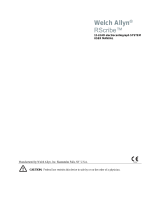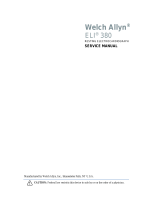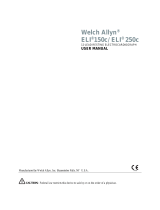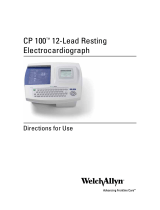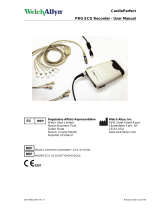Page is loading ...

Welch Allyn
®
ELI
®
230
12-Lead Resting Electrocardiograph
User Manual
Manufactured by Welch Allyn, Inc. Skaneateles Falls, NY U.S.A.
CAUTION: Federal law restricts this device to sale by or on the order of a physician.

© 2020 Welch Allyn Inc. All rights reserved. No one is permitted to reproduce or duplicate, in any form, this
instructions for use or any part thereof without permission from Welch Allyn. Welch Allyn is a registered trademark
of Welch Allyn, Inc. AM12, ELI, VERITAS, and WAM are trademarks of Welch Allyn, Inc. Hillrom™ is a trademark of Hill-
Rom Services, Inc. Software V1.2.x.
The information in this document is subject to change without notice.
PATENT/PATENTS
hillrom.com/patents
May be covered by one or more patents. See above Internet address. The Hill-Rom companies are the proprietors of
European, US, and other patents and pending patent applications.
Hillrom Technical Support
For information about any Hillrom product, contact Hillrom Technical Support at 1.888.667.8272,
mor_tech.support@hillrom.com.
9515-175-50-ENG REV L
Revision Date: 2020-09
901130 ELECTROCARDIOGRAPH
and EU IMPORTER
Welch Allyn, Inc.
4341 State Street Road
Skaneateles Falls, NY 13153 USA
Welch Allyn Limited
Navan Business Park, Dublin Road,
Navan, Co. Meath C15 AW22
Ireland
Authorized Australian Sponsor
Welch Allyn Australia Pty. Ltd.
Unit 4.01, 2-4 Lyonpark Road
Macquarie Park NSW 2113
Phone 800 650 083
hillrom.com
Welch Allyn, Inc. is a subsidiary of Hill-Rom Holdings, Inc.

Page | 2
TABLE OF CONTENTS
1. NOTICES ............................................................................................................................................................... 4
MANUFACTURER’S RESPONSIBILITY ............................................................................................................................................. 4
RESPONSIBILITY OF THE CUSTOMER ............................................................................................................................................. 4
EQUIPMENT IDENTIFICATION ...................................................................................................................................................... 4
COPYRIGHT AND TRADEMARK NOTICES ........................................................................................................................................ 4
OTHER IMPORTANT INFORMATION .............................................................................................................................................. 5
NOTICE TO EU USERS AND/OR PATIENTS ...................................................................................................................................... 5
2. WARRANTY INFORMATION .................................................................................................................................. 6
YOUR WELCH ALLYN WARRANTY ................................................................................................................................................ 6
3. USER SAFETY INFORMATION ................................................................................................................................ 8
4. EQUIPMENT SYMBOLS AND MARKINGS .............................................................................................................. 14
DEVICE SYMBOL DELINEATION .............................................................................................................................. .................... 14
PACKAGE SYMBOL DELINEATION ............................................................................................................................................... 17
5. GENERAL CARE ................................................................................................................................................... 18
PRECAUTIONS ....................................................................................................................................................................... 18
INSPECTION .......................................................................................................................................................................... 18
CLEANING AND DISINFECTING THE ELI 230 ........................................................................................................................... ...... 18
DISPOSAL ............................................................................................................................................................................. 19
6. ELECTROMAGNETIC COMPATIBILITY (EMC) ........................................................................................................ 20
7. INTRODUCTION .................................................................................................................................................. 24
MANUAL PURPOSE .............................................................................................................................. ................................... 24
AUDIENCE ............................................................................................................................................................................ 24
SYSTEM DESCRIPTION ............................................................................................................................................................. 24
INTENDED USE ...................................................................................................................................................................... 24
INDICATIONS FOR USE .............................................................................................................................. ............................... 25
ELI 230, SYSTEM ILLUSTRATION ............................................................................................................................................... 26
ELI 230 SPECIFICATIONS ......................................................................................................................................................... 31
ACCESSORIES ......................................................................................................................................................................... 32
REPLACEMENT ACQUISITION MODULES AND LEAD SETS ................................................................................................................ 32
ELECTRODES ......................................................................................................................................................................... 33
8. EQUIPMENT PREPARATION ................................................................................................................................ 34
CONNECTING THE ACQUISITION MODULE ................................................................................................................................... 34
LOADING PAPER .................................................................................................................................................................... 35
APPLYING POWER .................................................................................................................................................................. 36
SETTING DATE AND TIME .............................................................................................................................. ........................... 37
USING THE AM12 ACQUISITION MODULE .............................................................................................................................. .... 37
USING THE WAM (WIRELESS ACQUISITION MODULE) .................................................................................................................. 37
9. RECORD AN ECG ................................................................................................................................................. 38
PATIENT PREPARATION ........................................................................................................................................................... 38
PATIENT HOOKUP .................................................................................................................................................................. 38
PATIENT DEMOGRAPHIC ENTRY ................................................................................................................................................ 40
ECG ACQUISITION, PRINTING, STORAGE .................................................................................................................................... 40

TABLE OF CONTENTS
Page | 3
ACQUIRING AN ECG USING THE WAM ...................................................................................................................................... 43
ACQUIRING RHYTHM STRIPS .................................................................................................................................................... 43
TRANSFER TO A USB MEMORY STICK ........................................................................................................................................ 44
DELETING RECORDS .............................................................................................................................. .................................. 44
10. SYSTEM SETTINGS .......................................................................................................................................... 45
ACCESSING CONFIGURATION MENUS ......................................................................................................................................... 45
SUMMARY OF CONFIGURATION MENUS ..................................................................................................................................... 46
CONFIGURATION SETTINGS ...................................................................................................................................................... 47
11. MAINTENANCE AND TROUBLESHOOTING ....................................................................................................... 51
SYSTEM TROUBLESHOOTING CHART ........................................................................................................................................... 51
ECG TROUBLESHOOTING CHART .............................................................................................................................. ................. 51
TEST OPERATION ................................................................................................................................................................... 51
RECOMMENDATIONS TO BIOMEDICAL STAFF ............................................................................................................................... 52
BATTERY MAINTENANCE ......................................................................................................................................................... 52
CLEANING THE THERMAL PRINTER ............................................................................................................................................. 52

Page | 4
1. NOTICES
Manufacturer’s Responsibility
Welch Allyn, Inc. is responsible for the effects on safety and performance only if:
• Assembly operations, extensions, readjustments, modifications, or repairs are carried out only by
persons authorized by Welch Allyn, Inc.
• The device is used in accordance with the instructions for use.
Responsibility of the Customer
The user of this device is responsible for ensuring the implementation of a satisfactory maintenance schedule.
Failure to do so may cause undue failure and possible health hazards.
Equipment Identification
Welch Allyn, Inc. equipment is identified by a serial and reference number on the bottom of the device. Care should
be taken so that these numbers are not defaced.
The ELI 230 product label is applied showing the unique identification numbers along with other important
information printed on the label.
The serial number format is as follows:
YYYWWSSSSSSS
YYY = First Y is always 1 followed by two-digit Year of manufacture
WW = Week of manufacture
SSSSSSS = Sequence number of manufacture
The UDI label (when applicable) is placed below the product label.
AMXX Module Identification
The wired Acquisition Module is identified with a product label on the back of the device and will have its own
unique serial number and UDI label applied.
Wireless Module Identification
The Wireless Acquisition Module (WAM) is identified with a product label on the back of the device and has its
own unique serial number and UDI label applied. When the ELI 230 is configured for the WAM, the UTK label is
placed to the right of the product label.
Copyright and Trademark Notices
This document contains information that is protected by copyright. All rights are reserved. No part of this
document may be photocopied, reproduced, or translated to another language without prior written consent of
Welch Allyn, Inc.

NOTICES
Page | 5
Other Important Information
The information in this document is subject to change without notice.
Welch Allyn, Inc. makes no warranty of any kind with regard to this material including, but not limited to, implied
warranties of merchantability and fitness for a particular purpose. Welch Allyn, Inc. assumes no responsibility for any
errors or omissions that may appear in this document. Welch Allyn, Inc. makes no commitment to update or to keep
current the information contained in this document.
Notice to EU Users and/or Patients
Any serious incident that has occurred in relation to the device, should be reported to the manufacturer and the
competent authority of the Member State in which the user and/or patient is established.

Page | 6
2. WARRANTY INFORMATION
Your Welch Allyn Warranty
WELCH ALLYN, INC. (hereafter referred to as “Welch Allyn”) warrants that components within Welch Allyn
products (hereafter referred to as “Product/s”) will be free from defects in workmanship and materials for the
number of years specified on documentation accompanying the product, or previously agreed to by the
purchaser and Welch Allyn, or if not otherwise noted, for a period of twenty-four (24) months from the date of
shipment.
Consumable, disposable or single use products such as, but not limited to, PAPER or ELECTRODES are warranted
to be free from defects in workmanship and materials for a period of 90 days from the date of shipment or the
date of first use, whichever is sooner.
Reusable product such as, but not limited to, BATTERIES, BLOOD PRESSURE CUFFS, BLOOD PRESSURE HOSES,
TRANSDUCER CABLES, Y-CABLES, PATIENT CABLES, LEAD WIRES, MAGNETIC STORAGE
MEDIUMS, CARRY CASES or MOUNTS, are warranted to be free from defects in workmanship and materials for a
period of 90 days. This warranty does not apply to damage to the Product/s caused by any or all of the following
circumstances or conditions:
a) Freight damage;
b) Parts and/or accessories of the Product/s not obtained from or approved by Welch Allyn;
c) Misapplication, misuse, abuse, and/or failure to follow the Product/s instruction sheets and/or
information guides;
d) Accident; a disaster affecting the Product/s;
e) Alterations and/or modifications to the Product/s not authorized by Welch Allyn;
f) Other events outside of Welch Allyn’s reasonable control or not arising under normal operating conditions.
THE REMEDY UNDER THIS WARRANTY IS LIMITED TO THE REPAIR OR REPLACEMENT WITHOUT CHARGE FOR LABOR
OR MATERIALS, OR ANY PRODUCT/S FOUND UPON EXAMINATION BY
WELCH ALLYN TO HAVE BEEN DEFECTIVE. This remedy shall be conditioned upon receipt of notice by Welch Allyn of
any alleged defects promptly after discovery thereof within the warranty period. Welch Allyn’s obligations under the
foregoing warranty will further be conditioned upon the assumption by the purchaser of the Product/s (i) of all
carrier charges with respect to any Product/s returned to Welch Allyn’s principal place or any other place as
specifically designated by Welch Allyn or an authorized distributor or representative of Welch Allyn, and (ii) all risk
of loss in transit. It is expressly agreed that the liability of Welch Allyn is limited and that Welch Allyn does not
function as an insurer. A purchaser of a Product/s, by its acceptance and purchase thereof, acknowledges and agrees
that Welch Allyn is not liable for loss, harm, or damage due directly or indirectly to an occurrence or consequence
therefrom relating to the Product/s. If Welch Allyn should be found liable to anyone under any theory (except the
expressed warranty set forth herein) for loss, harm, or damage, the liability of Welch Allyn shall be limited to the
lesser of the actual loss, harm, or damage, or the original purchase price of the Product/s when sold.

WARRANTY INFORMATION
Page | 7
EXCEPT AS SET FORTH HEREIN WITH RESPECT TO REIMBURSEMENT OF LABOR CHARGES, A PURCHASER’S SOLE
EXCLUSIVE REMEDY AGAINST WELCH ALLYN FOR CLAIMS RELATING TO THE PRODUCT/S FOR ANY AND ALL LOSSES
AND DAMAGES RESULTING FROM ANY CAUSE SHALL BE THE REPAIR OR REPLACEMENT OF DEFECTIVE PRODUCT/S
TO THE EXTENT THAT THE DEFECT IS NOTICED AND WELCH ALLYN IS NOTIFIED WITHIN THE WARRANTY PERIOD. IN
NO EVENT, INCLUDING THE CLAIM FOR NEGLIGENCE, SHALL WELCH ALLYN BE LIABLE FOR INCIDENTAL, SPECIAL, OR
CONSEQUENTIAL DAMAGES, OR FOR ANY OTHER LOSS, DAMAGE, OR EXPENSE OF ANY KIND, INCLUDING LOSS OF
PROFITS, WHETHER UNDER TORT, NEGLIGENCE OR STRICT LIABILITY THEORIES OF LAW, OR OTHERWISE. THIS
WARRANTY IS EXPRESSLY IN LIEU OF ANY OTHER WARRANTIES, EXPRESS OR IMPLIED, INCLUDING, BUT NOT LIMITED
TO THE IMPLIED WARRANTY OF MERCHANTABILITY AND THE WARRANTY OF FITNESS FOR A PARTICULAR PURPOSE.

Page | 8
3. USER SAFETY INFORMATION
WARNING: Means there is the possibility of personal injury to you or others.
Caution: Means there is the possibility of damage to the device.
Note: Provides information to further assist in the use of the device.
WARNING(S)
• This manual gives important information about the use and safety of this device. Deviating from
operating procedures, misuse or misapplication of the device, or ignoring specifications and
recommendations could result in increased risk of harm to users, patients and bystanders, or damage to
the device.
• Device captures and presents data reflecting a patient’s physiological condition that when reviewed by a
trained physician or clinician can be useful in determining a diagnosis; however, the data should not be used
as a sole means for determining a patient’s diagnosis.
• Users are expected to be licensed clinical professionals knowledgeable about medical procedures and
patient care, and adequately trained in the use of this device. Before attempting to use this device for
clinical applications, the operator must read and understand the contents of the user manual and other
accompanying documents. Inadequate knowledge or training could result in increased risk of harm to
users, patients and bystanders, or damage to the device. Contact Welch Allyn service for additional training
options.
• To ensure that electrical safety is maintained during operation from AC (~) power, the device must be
plugged into a hospital-grade outlet.
• Only use parts and accessories supplied with the device and/or are available through Welch Allyn, Inc.
• Patient cables intended for use with the device include series resistance (9 Kohm minimum) in each lead
for defibrillation protection. Patient cables should be checked for cracks or breakage prior to use.
• Conductive parts of the patient cable, electrodes, and associated connections of type CF applied parts,
including the neutral conductor of the patient cable and electrode, should not come into contact with other
conductive parts including earth ground.
• ECG electrodes could cause skin irritation; patients should be examined for signs of irritation or inflammation.
• To avoid the possibility of serious injury or death during patient defibrillation, do not come into contact with
device or patient cables. Additionally, proper placement of defibrillator paddles in relation to the electrodes
is required to minimize harm to the patient.
• Proper clinical procedure must be employed to prep the electrode sites and to monitor the patient for
excessive skin irritation, inflammation, or other adverse reactions. Electrodes are intended for short-term use
and should be removed from the patient promptly following testing.

USER SAFETY INFORMATION
Page | 9
• To avoid potential for spread of disease or infection, single-use disposable components (e.g., electrodes)
must not be reused. To maintain safety and effectiveness, electrodes must not be used beyond their
expiration date.
• A possible explosion hazard exists. Do not use the device in the presence of a flammable anesthetic mixture.
• Where the integrity of external protective earth conductor arrangement is in doubt, the device shall be
operated from its internal electrical power source.
• Medical devices have been designed to have a higher degree of protection against electric shock than, for
instance, information technology equipment because patients often are connected to multiple devices and
also may be more prone to the adverse effect of electric currents than healthy persons. All equipment that is
connected to the patient, can be touched by the patient, or can be touched by another person while that
person touches the patient at the same time, should have the same level of protection against electric shock
as medical equipment. The ELI 230 is a medical device that has been designed to be connected to other
devices for the purpose of receiving and transmitting data. Certain measures must be taken to prevent the
risk of excessive electric current flow through the operator or patient when connected:
• All electrical equipment that is not medical electrical equipment must be placed outside of the
“patient environment,” defined by applicable safety standards to be at least 1.5 meters (5 feet) from
the patient. Alternatively, non-medical equipment may be provided with additional protection such as
an additional protective earth connection.
• All medical electrical equipment that has a physical connection to the ELI 230 or the patient, or is in the
patient environment must comply with applicable safety standards for medical electrical devices.
• All electrical equipment that is not medical electrical equipment and has a physical connection to the
ELI 230 must comply with applicable safety standards, such as IEC 60950 for information technology
equipment. This includes information network equipment connected through the LAN connector.
• Conductive (metal) parts that can be touched by the operator in normal use and that are connected to
non- medical equipment should not be brought into the patient environment. Examples are connectors
for shielded Ethernet or USB cables.
• If multiple devices are connected to each other or to the patient, device chassis and patient leakage
currents may be increased, and should be measured for compliance with applicable standards for
medical electrical systems.
• Avoid the use of portable multiple socket outlets. If used and not compliant with medical electrical
device standards, an additional protective earth connection is required.
• To prevent electric shock due to unequal ground potentials that may exist between points of a distributed
network system or fault conditions in external network connected equipment, network cable shielding
(where used) must be connected to protective earth ground appropriate to the area where the device is
used.
• The device has not been designed for use with high-frequency (HF) surgical equipment and does not provide
a protective means against hazards to the patient.
• When the 40 Hz filter is used, the frequency response requirement for diagnostic ECG equipment cannot
be met. The 40 Hz filter significantly reduces high-frequency components of the ECG and pacemaker spike
amplitudes, and is recommended only if high-frequency noise cannot be reduced by proper procedures.

USER SAFETY INFORMATION
Page | 10
• The quality of the signal produced by the device may be adversely affected by the use of other
medical equipment, including but not limited to defibrillators and ultrasound machines.
• For proper operation and the safety of users or patients and bystanders, equipment and accessories
must be connected only as described in this manual.
• This product complies with relevant electro-magnetic interference, mechanical safety, performance, and
biocompatibility standards. However, the product cannot completely eliminate potential patient or user
harm from the following:
•
Harm or device damage associated with electro-magnetic hazards,
•
Harm from mechanical hazards,
•
Harm from device, function, or parameter unavailability,
•
Harm from misuse error, such as inadequate cleaning, and/or
• The device and IT Network the device is connected to should be securely configured and maintained per
the IEC 80001 standard, or an equivalent network security standard or practice.
Caution(s)
• To prevent possible damage to the keyboard, do not use sharp or hard objects to depress keys, only
use fingertips.
• Do not attempt to clean the device or patient cables by submersing into a liquid, autoclaving, or steam
cleaning as this may damage equipment or reduce its usable life. Wipe the exterior surfaces with a warm
water and mild detergent solution and then dry with a clean cloth. Use of unspecified cleaning/disinfecting
agents, failure to follow recommended procedures, or contact with unspecified materials could result in
increased risk of harm to users, patients and bystanders, or damage to the device.
• No user-serviceable parts inside. Screw removal by qualified service personnel only. Damaged or suspected
inoperative equipment must be immediately removed from use and must be checked/repaired by qualified
service personnel prior to continued use.
• The rechargeable internal battery is a sealed lead-acid type and it is totally maintenance free. If the
battery appears to become defective, refer to Welch Allyn, Service Department.
• Do not pull or stretch patient cables as this could result in mechanical and/or electrical failures. Patient
cables should be stored after forming them into a loose loop.
• No calibration or special equipment is needed for the proper operation or maintenance of the device.
• The WAM will only work with receiving devices that are equipped with the appropriate option.
• No user-serviceable parts are inside the WAM. Damaged or suspected inoperative equipment must be
immediately removed from use and must be checked/repaired by qualified service personnel prior to
continued use.
• This WAM is not recommended for use in the presence of imaging equipment such as Magnetic
Resonance Imaging (MRI) and Computed Tomography (CT) devices, etc.
• The following equipment may cause interference with the WAM RF channel: microwave ovens, diathermy
units with LANs (spread spectrum), amateur radios, and government radar.

USER SAFETY INFORMATION
Page | 11
• AA batteries are known to leak their contents when stored in unused equipment. Remove battery from
WAM when not used for an extended period of time.
• Be careful to insert the connector block into the appropriate input connector by matching the lead wire labels
to the WAM or AM12 label.
• When necessary, dispose of the device, its components and accessories (e.g., batteries, cables,
electrodes), and/or packing materials in accordance with local regulations.

USER SAFETY INFORMATION
Page | 12
Note(s)
• Patient movements may generate excessive noise that may affect the quality of the ECG traces and the
proper analysis performed by the device.
• Proper patient preparation is important to proper application of ECG electrodes and operation of the device.
• There is no known safety hazard if other equipment, such as pacemakers or other stimulators, is
used simultaneously with the device; however, disturbance to the signal may occur.
• The WAM LEDs will automatically start flashing if the batteries have been discharged below 1.0 volts.
• During normal WAM/AM12 operation, the green LED will display continuously.
• If the WAM battery cover is opened during transmission, the device will stop transmitting. The battery must
be reinserted and the cover must be applied to resume operation.
• The WAM will automatically turn off (LEDs off) if the battery has been severely discharged.
• The WAM will automatically turn off when the electrocardiograph is powered down.
• The WAM will automatically turn off after being disconnected from the patient. This will happen regardless of
ELI 230 battery/AC power state.
• The display of absent waveform display while using the AM12 acquisition module could be due to an
improper auto-calibration. Reconnect the AM12 or power cycle the electrocardiograph.
• Square waves on the display and rhythm printout could be due to the WAM or the AM12 lead wires not
being connected to the patient.
• A square wave presentation on the display while using the WAM may be due to the WAM being turned off,
having no battery, not being paired correctly, operating out of range, or due to a calibration error. Review
the LED indicator on the WAM to ensure the unit is turned on, has proper battery level, is paired correctly,
and is within recommended proximity of the electrocardiograph, or power cycle the WAM to re-calibrate.
• If an electrode is not connected properly to the patient, or one or more of the patient cable lead wires are
damaged, the display will indicate a lead fault for the lead(s) where the condition is present and if the signal
is being printed, the respective lead(s) will print out as a square wave. Overload or saturation of amplifier
inputs will also result in lead fault indications.
• As defined by IEC 60601-1 and IEC 60601-2-25, the device is classified as follows:
• Class I equipment or internally powered.
• Type CF defibrillation-proof applied parts.
• Ordinary equipment.
• Equipment not suitable for use in the presence of a flammable anesthetic mixture.
• Continuous operation.
NOTE: From a safety perspective, per IEC 60601-1 and derivative standards/norms, this device is declared
to be “Class I” and uses a three-prong inlet to ensure an earth connection is made along with mains. The
ground terminal on the mains inlet is the only protective earth point in the device. Exposed metal
accessible during normal operation is double insulated from mains. Internal connections to earth ground
are functional earth.

USER SAFETY INFORMATION
Page | 13
• This device is intended to be used in a hospital or doctor’s office setting, and should be used and
stored according to the environmental conditions specified below:
Operating temperature: +10° to +40° C (+50° to +104° F)
Operating humidity: 10% to 95% RH, non-condensing
Storage temperature: -40° to +70° C (-40° to +158° F)
Storage humidity: 10% to 95% RH, non-condensing
Atmospheric pressure: 500 hPa to 1060 hPa
• WAM™ (wireless acquisition module) must be paired to electrocardiograph before operation.
• Device must be configured at the factory for use with the WAM.
• After operating the device using battery power, always reconnect the power cord. This ensures that the
batteries will be automatically recharged for the next time you use the device. A light next to the on/off
switch will illuminate indicating that the device is charging. This light will turn off when the battery is fully
charged.
• The power supply cord and appliance inlet serve as the means to disconnect the unit from the mains
power supply. To remove mains power from the unit, disconnect the power supply cord from the
appliance inlet.
• The device is UL classified:
WITH RESPECT TO ELECTRIC SHOCK, FIRE AND MECHANICAL
HAZARDS ONLY IN ACCORDANCE WITH IEC 60601-1, CAN/CSA
C22.2 No. 60601-1 and IEC 60601-2-25

Page | 14
4. EQUIPMENT SYMBOLS AND MARKINGS
Device Symbol Delineation
ECG
RHY
ECG
WARNING The warning statements in this manual identify conditions or practices
that could lead to illness, injury, or death. In addition, when used on a patient
applied part, this symbol indicates defibrillation protection is in the cables.
Warning symbols will appear with a grey background in a black and white
document.
CAUTION The caution statements in this manual identify conditions or practices
that could result in damage to the equipment or other property, or loss of data.
Alternating current
Protective earth
Battery Charging Indicator
ECG Patient Cable Input
Version 2 UTK indicator (next to ECG Input)
Defibrillator-proof type CF applied part
ON/OFF (power)
Continuous Rhythm
12-Lead ECG
Do not dispose as unsorted municipal waste. Requires separate handling for
waste disposal according to local requirements
Antenna

EQUIPMENT SYMBOLS AND MARKINGS
Page | 15
Indicates compliance to applicable European Union directives
Non-ionizing electromagnetic radiation
Follow instructions/directions for use (DFU) -- mandatory action. A copy of the
DFU is available on this website. A printed copy of the DFU can be ordered
from Hillrom for delivery within 7 calendar days.
Medical Device
Model identifier
Reorder Number
Serial Number
Manufacturer
Authorized representative in the European Community
Global Trade Item Number
Australian Communications and Media
Authority (ACMA) Radio Compliance
Mark (RCM).

EQUIPMENT SYMBOLS AND MARKINGS
Page | 16
KC Mark (South Korea)
Radio approval symbol for Pakistan
Conatel Approval symbol for Paraguay
Eurasia Certification
UL approved mark
CE symbol
Verbiage may vary. Background may be yellow if print is not
black and white
Do not re-use, Single use device
Lot number
Use by date
Read the instruction for use
Not made with natural rubber latex
Prescription only or "For Use by or on the order of a
licensed medical professional"

EQUIPMENT SYMBOLS AND MARKINGS
Page | 17
Package Symbol Delineation
Keep away from sunlight
This way up
Fragile
Keep dry
Temperature limit
Humidity limitation
Atmospheric pressure limitation
Contains Non-spillable Battery

Page | 18
5. GENERAL CARE
Precautions
• Turn off the device before inspecting or cleaning.
• Do not immerse the device in water.
• Do not use organic solvents, ammonia-based solutions, or abrasive cleaning agents which may
damage equipment surfaces.
Inspection
Inspect your equipment daily prior to operation. If you notice anything that requires repair, contact an
authorized service person to make the repairs.
• Verify that all cords and connectors are securely seated.
• Check the case and chassis for any visible damage.
• Inspect cords and connectors for any visible damage.
• Inspect keys and controls for proper function and appearance.
Cleaning and Disinfecting the ELI 230
Disinfecting agents
The ELI 230 is compatible with the following disinfectants:
•
Clorox Healthcare® Bleach Germicidal Wipes (use according to instructions on product label), or
•
a soft, lint-free cloth dampened with a solution of sodium hypochlorite (10% household bleach and water
solution) minimum 1:500 dilution (minimum 100 ppm free chlorine) and maximum 1:10 dilution as
recommended by the APIC Guidelines for Selection and Use of Disinfectants.
Caution: Disinfecting or cleaning agents that contain Quaternary Ammonium Compounds (Ammonium
Chlorides) have been identified as having negative effects if used to disinfect the product. Use of such agents
may result in discoloration, cracking, and deterioration of the external housing of the device.
Cleaning
To clean the ELI 230:
1. Disconnect the power source.
2. Remove cables and lead wires from device before cleaning.
3. Thoroughly wipe the surface of the ELI 230 with a clean, lint-free cloth dampened with a mild
detergent and water for general cleaning or use one of the above recommended agents for
disinfection.
4. Dry the device with a clean, soft, dry, lint-free cloth.

GENERAL CARE
Page | 19
WARNING:
Prevent liquid from penetrating the device and do not attempt to clean/disinfect the device or patient cables by
submerging into a liquid, autoclaving, or steam cleaning.
Do not expose cables to strong ultra-violet radiation.
Do not sterilize the device or lead wires with Ethylene Oxide (EtO) gas.
Do not immerse cable ends or lead wires; immersion can cause metal corrosion. Use caution with excess liquid as
contact with metal parts may cause corrosion.
Do not use excessive drying techniques such as forced heat.
Improper cleaning products and processes can damage the device, produce brittle lead wires and cables, corrode
the metal, and void the warranty. Use care and proper procedure whenever cleaning or maintaining the device.
Disposal
Disposal must be in accordance with the following steps:
1. Follow cleaning and disinfection instructions per instructions in this user manual section.
2. Delete all existing data related to patients/hospital/clinic/doctor. Data backup may be performed prior to
deletion.
3. Segregate material in preparation for the recycling process
• Components are to be disassembled and recycled based on type of material
o Plastic to be recycled as plastic waste
o Metal to be recycled as Metals
• Includes loose components containing more than 90% metal by weight
• Includes screws and fasteners
o Electronic components, including the power cord, to be disassembled and recycled as Waste of
Electrical and Electronic Equipment (WEEE)
o Batteries to be dismantled form the device and recycled as per WEEE
Users must adhere to all federal, state, regional, and/or local laws and regulations as it pertains to the safe disposal of
medical devices and accessories. If in doubt, the user of the device shall first contact Hillrom Technical Support for
guidance on safe disposal protocols.
/
